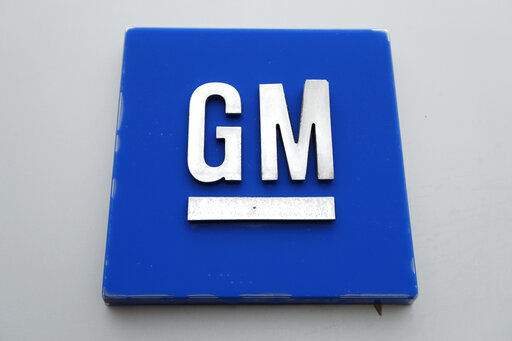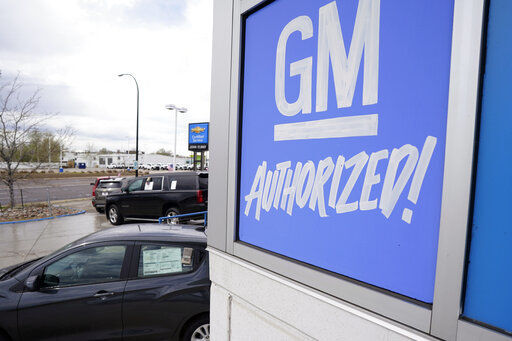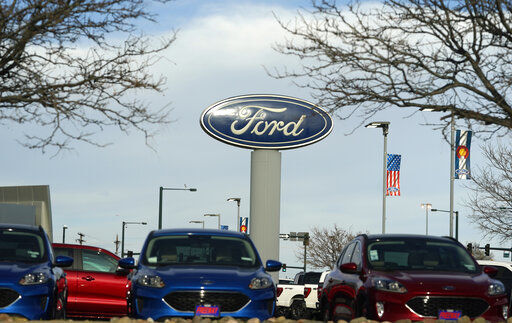DETROIT — The global computer chip shortage cut into third-quarter profits at both Ford and crosstown rival General Motors, with both companies having to temporarily close factories, pinching supplies on dealer lots.
Ford’s net income of $1.83 billion fell 23% from a year ago, while GM’s profit dropped 40% to $2.4 billion. High prices, mainly for the pickup trucks and big SUVs that the automakers sold, eased the sting from lower sales.
Ford, which reported results after Wednesday’s closing bell, said it would resume paying a dividend, 10 cents per share, starting in the fourth quarter. It will cost the company about $400 million per quarter. Ford’s stock jumped 7.5% in after-market trading.
The company said its revenue dropped 5% from a year ago to $35.68 billion. That fell short of Wall Street estimates of $38.2 billion.
Excluding one-time items, the Dearborn, Michigan, company made 51 cents per share, beating the 27 cents expected by analysts polled by FactSet.
Ford’s sales fell 27% from July through September in the U.S., its most lucrative market. The company also lost 2.4 percentage points of U.S. market share, largely because like GM, it couldn’t produce enough vehicles to meet demand.
But the average Ford new vehicle sold for more than $51,000 during the quarter, up almost 13% from a year ago, according to Edmunds.com.
Chief Financial Officer John Lawler said Ford has the cash and income to invest in electric vehicles and services. He said the company is confident in the trajectory of its business.
“That’s providing us the financial flexibility to fully fund our plan and all of our other capital needs,” he said. “We also are focused on total shareholder returns, not only appreciating stock price but also the dividends.”
Lawler said there is strong demand for Ford’s products that the company can’t meet because of the chip shortage. Globally, he said he thinks the company could sell 200,000 Mustang Mach-E electric SUVs per year.
He said the chip shortage should ease a bit from October through December, and sales to dealers should rise 10% this quarter over the previous one. While supplies will improve, the shortage will continue into next year and possibly into 2023, he said.
Ford raised its full-year pretax earnings outlook to between $10.5 billion and $11.5 billion, and said it plans to make capital investments of $40 billion to $45 billion from 2020 to 2025. That includes about $15 billion that will go toward battery-electric vehicles during the period.
Lawler cautioned, however, that the company faces higher costs in materials and freight. Commodity costs such as steel are expected to rise $3 billion to $3.5 billion this year, and another $1.5 billion next year, he said.
GM’s earnings fell from $4 billion last year as sales slumped and the company lost market share in the U.S., also its most profitable country. Revenue for the quarter plunged 25% to $26.78 billion.
GM CEO Mary Barra, meanwhile, said on a conference call with analysts that she is “pretty confident” that GM’s San Francisco-based Cruise autonomous vehicle subsidiary would be carrying passengers without human safety drivers sometime next year. To do that, Cruise still needs a final permit from California regulators.
Barra also told reporters Wednesday that the global shortage of semiconductors, plus COVID outbreaks at supplier factories, hit the company during the third quarter. “It still continues to be somewhat volatile,” she said.
However, GM is seeing improvement in the current quarter and expects additional supplies in the first three months of 2022.
GM has said it expects to produce about 200,000 fewer vehicles in the second half of this year compared with the first half, with most of the impact occurring from July through September.
Barra said she’s spoken with the CEOs of most major chip makers, and the companies are working on strategies to make sure the shortages don’t happen again. “I think we’ll definitely see changes to ensure we have the right supply,” she said.
GM’s profit came even though U.S. third-quarter sales were almost 33% lower than a year ago. The company lost 3.8 percentage points of U.S. market share, Edmunds said.
But Barra said she expects GM’s market share to bounce back when factories get back to normal production. “We are selling everything we can. I wish we had more vehicles,” she said.
Consumer willingness to pay high prices for scarce new vehicles kept the money flowing for GM. The average sale price paid for a GM vehicle topped $50,000 for the quarter, up more than 16% from a year ago, Edmunds said. Barra said that once supplies grow, she expects the high prices to ease.
With the expected improvement in chip supplies, GM increased its full-year net income guidance to a range of $8.1 billion to $9.6 billion. In the second quarter it had forecast $7.7 billion to $9.2 billion for the year.
Shares of GM closed Wednesday down 5.4% at $54.26.




